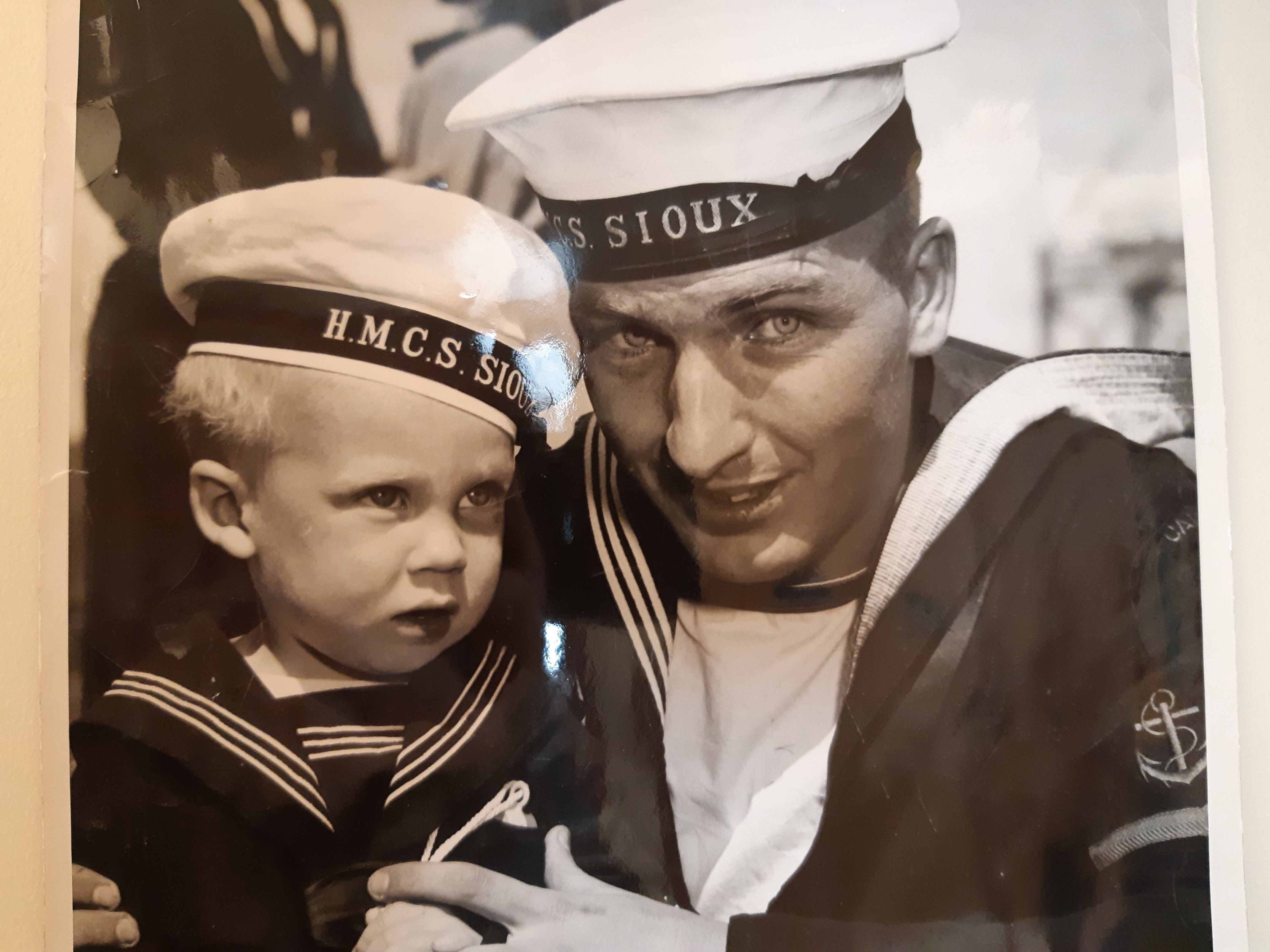Korean War veteran remembers the ‘forgotten war’
Navy News / March 11, 2022
By Peter Mallett
More than 70 years have passed since the deployment of Royal Canadian Navy (RCN) warships to Korea, but retired Chief Warrant Officer Tom Larkin has vivid memories of his days aboard Her Majesty’s Canadian Ship (HMCS) Sioux.
The V-class destroyer was one of three Canadian warships first deployed to Korea to begin the bombardment of Communist positions along the coastline. The enemy fought back by firing their own missiles, but Sioux never took a direct hit. It didn’t stop sailors’ nerves from being rattled when one fell and detonated alongside their ship, however.
“At the time, we never thought it was too dangerous because were too young and stupid to be afraid,” he says. “But yes, the explosions would have everyone on edge and when they exploded they would almost knock me out of my bunk when I was sleeping, or rattle me when they landed when I was at my signal lab post.”
Today, the 91 year old lives at Veterans’ Memorial Lodge in Victoria.
Whenever he thinks about his time in Korea, he also remembers the human cost of all wars. That’s because Mr. Larkin’s stepfather, Herbert Michaud, never returned home from war. He paid the ultimate price while serving with the Canadian Army during the Second World War and was killed while fighting with the Allies along the Gothic Line in southern Italy.
“He was a good man, was good to me, and was always there for the family whenever we needed him – but then he never came home from Europe,” says Mr. Larkin. “My (biological) father died from tuberculosis and I never really got to know him, either.”
Without a father and to help make ends’ meet on the home front, Mr. Larkin took a job loading fuel locomotives for the Canadian National Railway in Regina, while also working on local farms during harvest time. He admits he was saddled with more responsibility than most young men his age.
His mother, twice a widower, was left to raise him and his three siblings on her own.
In 1947, at the age of 17, he spied an article in the local newspaper reporting that the RCN was looking for recruits. The story caught his attention but his mother’s signature was required for him to enlist. Despite the tragic loss of his stepfather, she signed the forms. Within months, a young Larkin found himself doing his basic training at CFB Esquimalt, B.C.
The Cold War
After completing his basic training, Ordinary Seaman Larkin was assigned to HMCS Athabaskan as a signalman. He was brimming with enthusiasm about embarking on a naval career.
“Life in the Navy was great and I had an interesting career with lots of stuff to learn and existing skills to improve,” he says. “The other men were great companions and I admired the officers who treated us well and were fair, not like the Captain Blighs you read about in novels.”
He excelled as a signalman. While radio transmissions between ships could be intercepted by the enemy, reading their signals wasn’t so easy. Most signalmen could complete about 12 to 15 signals per minute in Morse code; Mr. Larkin says he could complete 20 per minute.
After getting proficient at signalling, his life and the world he lived in changed. In June 1950, Canada began UN military operations in Korea after the UN called on North Korea to withdraw its forces north of the 38th parallel.
Mr. Larkin was reassigned to HMCS Sioux. His ship, along with HMC Ships Cayuga and Athabaskan, carried out bombardments of Communist positions and chased enemy ships in the Yellow Sea, preventing them from landing.
The “Forgotten War”
After a seven-month deployment, Sioux returned home to Esquimalt briefly, only to deploy again two months later.
He agrees with the sentiment of many Korean War veterans and historians who refer to the Korean War as Canada’s “Forgotten War”. Mr. Larkin says there was little news coverage of the war back home in Canada and no heroes’ welcome for soldiers returning home from the battlefield, unlike in the First and Second World Wars.
After the war he remained in the Navy for more than two decades, rising to the rank of chief warrant officer (for more information on rank structure in that era, see below).
In the years following his military service he worked as in instructor at Fleet School, a dispatcher for the Pacific Pilotage Authority and the Saanich, B.C., detachment of the RCMP, and also a spell as park ranger for B.C. Provincial Parks.
A devoted husband for 66 years, Mr. Larkin and his wife, Joan, raised five children in the Victoria area. Over the years the family grew to include three grandchildren and four great-grandchildren.
“The family is super proud of Dad,” says son John Larkin. “Being a child of the 1960s, I didn’t immediately realize how important his military service in Korea was and only began to realize this later in life.”
Joan died in 2017. With declining health, Mr. Larkin moved into Veterans’ Memorial Lodge in the spring of 2019, and he uses a walker and a wheelchair to get around these days. John and his sisters, Judi, Kim and Kara, make regular visits to see him.
“He hasn’t lost his enthusiasm and still amazes us with his recollections of the war and his travels in the Navy and beyond,” says John.
*Of note, the Royal Canadian Navy, Royal Canadian Air Force and Canadian Army were unified into one organization – the Canadian Armed Forces (CAF) – in 1968. Under unification, Navy ranks were eliminated in favour of a single rank structure for the entire CAF. Under this system, Mr. Larkin retired at the rank of chief warrant officer instead of the Navy-specific rank of chief petty officer 1st class. By 2014, may of the changes brought in under unification were reversed.
Page details
- Date modified:
